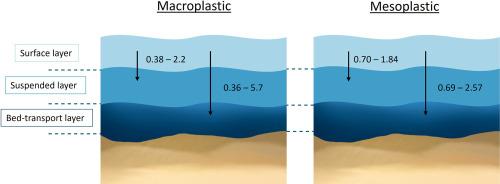当前位置:
X-MOL 学术
›
Water Res.
›
论文详情
Our official English website, www.x-mol.net, welcomes your
feedback! (Note: you will need to create a separate account there.)
Plastic transport in rivers: Bridging the gap between surface and water column
Water Research ( IF 11.4 ) Pub Date : 2024-11-07 , DOI: 10.1016/j.watres.2024.122768 Stephanie B. Oswald, Ad M.J. Ragas, Margriet M. Schoor, Frank P.L. Collas
Water Research ( IF 11.4 ) Pub Date : 2024-11-07 , DOI: 10.1016/j.watres.2024.122768 Stephanie B. Oswald, Ad M.J. Ragas, Margriet M. Schoor, Frank P.L. Collas

|
Rivers act as an important transportation pathway for land-based plastic litter to the ocean. Recently, rivers have also been identified as potential sinks and reservoirs for plastics. Knowledge of plastic transport over different depth profiles in rivers remains limited. In this study, we evaluated the vertical distribution of macro- and mesoplastics, using a larvae net and a trawl net in the river Rhine and its two major branches, i.e. Waal and IJssel. Subsequently, to estimate the relationship between the surface transport of plastic items, i.e., floating items, compared to the transport in deeper layers in the water column, including suspended and bed-transported plastic, an extrapolation factor was derived per day for the middle and bottom nets divided by those found in the surface net. The observed macro- and mesoplastic OSPAR categories collected in different layers in the water column were rather consistent between different sampling techniques. Fragments of soft mesoplastic falling under the category “Plastic film plastics 0–2.5 cm (soft)" were recorded most frequently in the investigated rivers with our monitoring techniques. During larvae net monitoring, hard plastics were more frequently found at the river surface than at the middle or bottom of the river for both macroplastic and mesoplastics, while soft plastics were more frequently detected near the bottom. For larvae net monitoring, the extrapolation factor, reflecting the concentration ratio of macroplastic items transport at different depths, i.e., from the surface downwards to the middle and the bottom ranged between 0.38 to 2.2 and 0.36 to 5.7, respectively. The extrapolation factor of mesoplastic transport from the surface downwards to the middle and the bottom ranged between 0.70 to 1.84 and 0.69 to 2.57. During trawl net monitoring, the extrapolation factor, reflecting the concentration ratio, for macroplastic ranged between 0.82 and 1.30, and for mesoplastic between 0.52 and 1.40. Overall, the findings of this study show that estimates of plastic concentrations solely based on surface transport could result in an under- or overestimation of riverine plastic transport.
中文翻译:

河流中的塑料运输:弥合地表和水柱之间的差距
河流是陆地塑料垃圾进入海洋的重要运输途径。最近,河流也被确定为塑料的潜在汇和水库。关于河流中不同深度剖面上的塑料传输的知识仍然有限。在这项研究中,我们使用幼虫网和拖网评估了莱茵河及其两个主要支流(即瓦尔河和艾塞尔河)中大型和中再生动物的垂直分布。随后,为了估计塑料物品(即漂浮物品)的表面运输与水柱中更深层运输(包括悬浮和床运输塑料)之间的关系,得出了每天中网和底网的外推因子除以表面网中的外推因子。在水柱的不同层中观察到的宏观和中胚层 OSPAR 类别在不同采样技术之间相当一致。使用我们的监测技术,属于“0-2.5 厘米(软)塑料薄膜”类别的软中塑碎片在调查的河流中记录得最频繁。在幼虫网监测期间,对于大塑性和中塑性,硬塑料在河面比在河流中部或底部更常见,而软塑料在底部附近更常见。对于幼虫网监测,反映在不同深度(即从表面向下到中间和底部)运输的大塑胶物品浓度比的外推因子分别在 0.38 至 2.2 和 0.36 至 5.7 之间。中塑性从表面向下到中间和底部的传输的外推因子范围在 0.70 到 1.84 到 0 之间。69 到 2.57。在拖网监测期间,反映浓度比的外推因子(反映浓度比)的巨型塑料在 0.82 到 1.30 之间,中塑性在 0.52 到 1.40 之间。总体而言,本研究的结果表明,仅基于地面运输的塑料浓度估计可能会导致对河流塑料运输的低估或高估。
更新日期:2024-11-07
中文翻译:

河流中的塑料运输:弥合地表和水柱之间的差距
河流是陆地塑料垃圾进入海洋的重要运输途径。最近,河流也被确定为塑料的潜在汇和水库。关于河流中不同深度剖面上的塑料传输的知识仍然有限。在这项研究中,我们使用幼虫网和拖网评估了莱茵河及其两个主要支流(即瓦尔河和艾塞尔河)中大型和中再生动物的垂直分布。随后,为了估计塑料物品(即漂浮物品)的表面运输与水柱中更深层运输(包括悬浮和床运输塑料)之间的关系,得出了每天中网和底网的外推因子除以表面网中的外推因子。在水柱的不同层中观察到的宏观和中胚层 OSPAR 类别在不同采样技术之间相当一致。使用我们的监测技术,属于“0-2.5 厘米(软)塑料薄膜”类别的软中塑碎片在调查的河流中记录得最频繁。在幼虫网监测期间,对于大塑性和中塑性,硬塑料在河面比在河流中部或底部更常见,而软塑料在底部附近更常见。对于幼虫网监测,反映在不同深度(即从表面向下到中间和底部)运输的大塑胶物品浓度比的外推因子分别在 0.38 至 2.2 和 0.36 至 5.7 之间。中塑性从表面向下到中间和底部的传输的外推因子范围在 0.70 到 1.84 到 0 之间。69 到 2.57。在拖网监测期间,反映浓度比的外推因子(反映浓度比)的巨型塑料在 0.82 到 1.30 之间,中塑性在 0.52 到 1.40 之间。总体而言,本研究的结果表明,仅基于地面运输的塑料浓度估计可能会导致对河流塑料运输的低估或高估。


















































 京公网安备 11010802027423号
京公网安备 11010802027423号